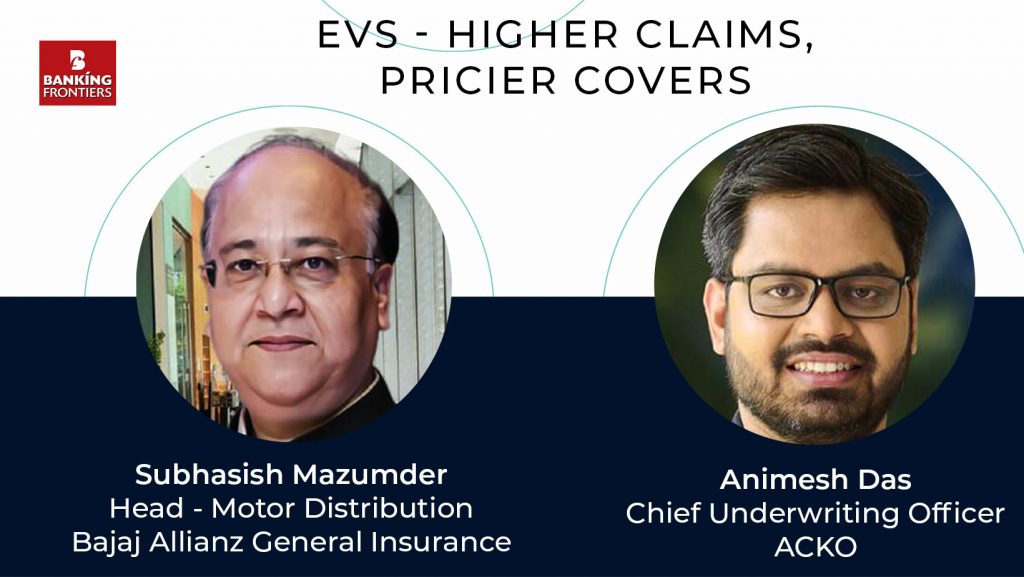2 experts from the leading general insurance companies shared their perspectives on growth & opportunities for EV insurance business in India:

Indian automobile industry is going from the transitory stage. Indian customers are still evolving concerning their usage, convenience of commute, and price point of vehicles being offered in the market. The adoption of EVs depends to a large extent on state government subsidies which vary as per respective state government policies. The availability of charging infrastructure also plays an important role in the uptake of EVs in India. Government policies and regulations with reference to battery scrappage, subsidies, localization of EV production, etc, will play a huge part in ensuring that this industry can accomplish the former’s NDC (Nationally Determined Contributions) ambition of an emissions-intensity target of 45% below 2005 levels by 2030; a target of achieving 50% cumulative electric power installed capacity from non-fossil fuel-based energy resources, by 2030.
Cities & Popular Brands
 Subhasish Mazumder, Head – Motor Distribution at Bajaj Allianz General Insurance says: “For the last financial year, the company saw growth in the EV insurance business in regions like Mumbai, Bengaluru, Delhi, and Pune among the other prominent metros and tier 2 & 3 cities.”
Subhasish Mazumder, Head – Motor Distribution at Bajaj Allianz General Insurance says: “For the last financial year, the company saw growth in the EV insurance business in regions like Mumbai, Bengaluru, Delhi, and Pune among the other prominent metros and tier 2 & 3 cities.”
Animesh Das, Chief Underwriting Officer, ACKO reveals: “ACKO General Insurance witnesses a major demand from Bangalore and Delhi for EV insurance. Ola and Ather scooters are popular brands among our customers.”
 Bajaj Auto, Hero Electric, Ampere, Okinawa, Revolt, Pure EV, Bgauss, TVS, and Okaya are popular brands among the 2-wheeler EV segment customers for Bajaj Allianz General Insurance. Subhasish adds: “Tata Motors, MG Motors, and Kia from our predominant customer base for our EV 4-wheeler segment. We have developed EV-specific insurance products to cater to the EV luxury segment like Volvo, BMW, Mercedes Benz, and Audi as well.”
Bajaj Auto, Hero Electric, Ampere, Okinawa, Revolt, Pure EV, Bgauss, TVS, and Okaya are popular brands among the 2-wheeler EV segment customers for Bajaj Allianz General Insurance. Subhasish adds: “Tata Motors, MG Motors, and Kia from our predominant customer base for our EV 4-wheeler segment. We have developed EV-specific insurance products to cater to the EV luxury segment like Volvo, BMW, Mercedes Benz, and Audi as well.”
He added: “Currently, the commercial vehicles market is quite segmented and most of our tie-ups are at the regional level with dealerships or via EV financing companies.”
Premium Calculation
The premium for EVs is determined based on a variety of factors compared to traditional cars. The major factors involved in determining the premium are the cost of the EV and the motor power. Animesh explains: “Since these vehicles tend to be more expensive than petrol cars, there is an increase in the cost of insurance premium. The other factors such as the make and model of the vehicle, age of the driver, and driver’s driving history are also considered.”
According to Subhasish, the damage premium is decided by insurance companies based on their loss experience while the third-party premium is fixed based on the motor capacity of the vehicle and not battery capacity.
EV V/S Fuel Vehicles
Animesh observes that electric vehicles are built on sophisticated technology that comes at a high cost. Further, the lightweight body and instant torque make the EVs prone to extensive damage. This in turn increases the liability of the insurer, leading to higher costs of insurance policies.
He shares further details: “There is high incident rate and the average claim size of EV is higher. Although insuring EVs is on the higher end, we consider lot of points and thereby offer prices above the industry standard for EV vehicles as compared to Internal Combustion Engine (ICE) vehicles.”
The green vehicle covers third-party premium rates are subsidized by the government. Subhasish says: “Bajaj Allianz has introduced industry-first innovative EV specific add-on covers and prompt customer service. We have also developed a complete eco-system for EV vehicles known as #EVForAll which has 11 specialized services like a dedicated EV helpline, SOS, on-site charging, pickup and drop facility. It also includes accommodation benefits, roadside repair, minor repair, urgent message replay, legal assistance, medical assistance, and taxi benefits.”
Strategies for Greener Tomorrow
Bajaj Allianz General Insurance EV motor insurance business contributes to a single-digit percentage of its overall motor insurance business which is growing rapidly across all our motor insurance segments. The company sees a largescale adoption in the 2-wheeler and commercial vehicle segments, while adoption in 4-wheeler passenger segment is lower. With the government’s push in developing charging infrastructure, there will be increased in EV adoption in the coming years.
The motor insurance company has witnessed the average claim cost for 2-wheeler EVs is approx. 20% more than ICEs. The primary reason is due to the less reparability of plastic/fiber parts used in 2-wheeler EVs and hence the cost of parts or replacement is higher.
Subhasish shares additional details: “The average claim cost for 4-wheeler EVs is about 50% more than ICEs primarily due to the non-reparability of electric parts. In addition, other body parts are also supplied without child parts and are costlier compared to normal vehicles.”
Read more:








